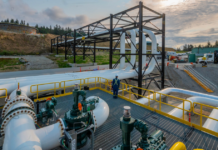The oil sands sector in Canada is expected to generate nearly half a trillion dollars in revenues for the government over the next three decades, according to a new analysis by the Canadian Energy Centre (CEC).
The analysis, based on data from Rystad Energy UCube, shows that under a conservative scenario of $60 USD per barrel for oil, the oil sands sector will contribute over US$420 billion to Canadian government coffers.
Additionally investments into capital projects from 2023 to 2050 could total nearly US$328 billion.
The CEC report also highlights how the oil sands sector is investing in low-emission technologies, such as carbon capture and storage (CCUS), to reduce its greenhouse gas emissions and achieve net zero targets.
According to the CEC these investments will help preserve the economic benefits of the oil sands sector for Canada, while also addressing the environmental challenges.
It also notes that Canadian government revenues from the oil sands sector, which include provincial royalties and federal and provincial corporate taxes, are projected to increase from US$12.1 billion in 2023 to US$19.4 billion in 2050.
Cumulative revenues over this period could be used to fund public services and programs for Canadians.
The report also estimates that annual capital expenditures in the oil sands sector will grow from US$10.6 billion in 2023 to US$12.6 billion in 2050.
Totalling a projected US$327.8 billion, which could invigorate employment, innovation and further supply chain development in Canada.
The CEC report concludes that the oil sands sector is a vital part of Canada’s future economy.
Earlier this year, the Texas-based oil giant ConocoPhillips Co. announced it would purchase Alberta’s Surmont oil sands project for $4.4 billion.
“We look forward to leveraging our position as 100% owner and operator of Surmont to further optimize the asset while progressing toward our overall interim and long-term emissions intensity objectives,” said ConocoPhillips CEO Ryan Lance in a press release.
“We will remain on track to achieve our previously announced accelerated GHG intensity reduction target of 50 to 60% by 2030.”






















